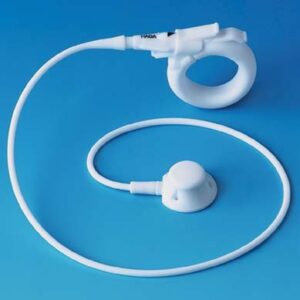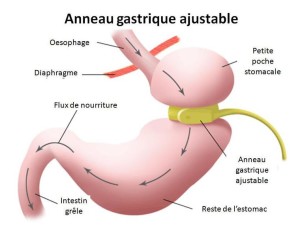Gastric banding: an effective solution to obesity
![]()
 Why gastric banding? Obesity and severe overweight are increasingly affecting populations in all industrialized countries, and are beginning to present a real challenge to scientific researchers and the medical profession in general. Faced with these phenomena, which are becoming real health problems on a global scale, technology is doing its bit to help people who suffer from unhealthy excess weight and who have tried every solution to no avail.
Why gastric banding? Obesity and severe overweight are increasingly affecting populations in all industrialized countries, and are beginning to present a real challenge to scientific researchers and the medical profession in general. Faced with these phenomena, which are becoming real health problems on a global scale, technology is doing its bit to help people who suffer from unhealthy excess weight and who have tried every solution to no avail.
Gastric banding is one of the increasingly common obesity treatment techniques. Today, we take a look at how it works, its results, constraints and risks.
Who can have a gastric band fitted?
 Gastric banding isn’t just for anyone who has a few extra kilos and is looking for a miracle solution to their overweight problem. The gastric band is intended for people who have been obese for at least 3 years, and who are overweight to the point where only surgery can put an end to it.
Gastric banding isn’t just for anyone who has a few extra kilos and is looking for a miracle solution to their overweight problem. The gastric band is intended for people who have been obese for at least 3 years, and who are overweight to the point where only surgery can put an end to it.
Gastric banding can be considered when an individual has a BMI (Body Mass Index) of over 35-40, associated with a health problem such as hypertension, diabetes, osteoarthritis or cardiovascular problems. If, after multiple dieting attempts supervised by healthcare professionals, no change is observed in the patient, then gastric banding may be considered by the treating practitioner.
The procedure: what does gastric banding involve?
The procedure involves placing a band on the upper part of the stomach. This ring defines a small pouch with a capacity of around 15 ml, which will accommodate the food ingested to an extremely limited extent. By mechanically reducing the stomach’s normal absorption capacity, a radical reduction in the amount of food ingested, and therefore calories absorbed, is achieved. The result is significantly rapid weight loss.

An example of a gastric band
The OMNIFORM-designed LAP-BAND APR, developed by French laboratories Allergan, offers an adjustable gastric band system that can be tightened or loosened as required, under medical supervision.
Adjustment of the pouch size takes place post-operatively, percutaneously, i.e. through the skin. The width of the ring is modified by injecting a filling fluid into it.

Careful consideration upstream
Having a gastric band fitted is a major decision, with far-reaching consequences for daily life. Before deciding to go ahead with the procedure, a full assessment is required, including several consultations with various health professionals: nutritionist, endocrinologist, psychiatrist, cardiologist and pulmonologist. A gastric fibroscopy will verify the condition of the stomach, its ability to withstand the operation and to retain the band.
During the operation
Gastric banding is performed under general anesthesia. The operation is performed by laparoscopy, a less invasive surgical technique that allows surgery without opening the abdominal cavity. Carbon dioxide (CO2) is introduced into the abdominal cavity, creating a positive pressure that lifts the wall and enables the surgeon to operate directly on the stomach, using a camera.
Gastric banding lasts around 1 hour, and is generally followed by 3 to 4 days’ hospitalization. Full recovery takes 8 to 10 days. There is very little pain after the operation, and only 3 scars of 1 to 1.5 cm, which are virtually invisible.
Rigorous post-operative follow-up
For gastric band surgery to be a success, long-term post-operative follow-up is essential. Eating is resumed gradually, initially with liquid or blended foods, followed by small, normal meals. Once all common foods have been successfully reintroduced into the daily diet, and only if the patient is no longer losing weight, the gastric band can be tightened to reduce the capacity of the food pouch once again. This tightening is performed without anesthesia and does not require surgical intervention. It is performed by the healthcare professional, under X-ray control.
Follow-up with a nutritionist, the surgeon, and possibly the psychiatrist is necessary to ensure that the patient adapts well to his or her new lifestyle.
How will I live my daily life with a gastric band?
The gastric band considerably reduces the size of the stomach. This makes it impossible to ingest large quantities of food. This is why eating disorders (BEDs), such as bulimia, compulsions and cravings, must be resolved before considering gastric banding.
The gastric band requires you to eat very, very slowly, in small bites, and to chew very well. As soon as you take your first bites, the pouch above the band is full, giving you a feeling of satiety. You must therefore wait for food to pass through the ring barrier, otherwise food will accumulate in the esophagus, leading to regurgitation and/or vomiting. Ideally, meals should last between 30 and 45 minutes, and should be taken in a calm, seated, stress-free place, to encourage slow food intake and avoid spasms, which would make eating impossible. Drinking during meals is strongly discouraged.
WARNING: certain meats and green salads tend to cause spasms, and should be either blended or permanently eliminated from the diet. Nibbling should be avoided, and a maximum of 3 meals a day should be eaten, to prevent dilation of the esophagus.
Finally, liquids should be taken slowly, in small sips, between meals, and never from the bottle. Carbonated beverages, even diet ones, should be avoided at all costs.
As you can see, gastric banding entails both rigorous and restrictive lifestyle changes, and the recommendations must be followed to the letter.
What results can I expect from gastric banding?

Results depend to a large extent on how rigorously dietary constraints are followed. Some people lose up to 80% of their excess weight in less than 2 years, with averages of around 50%. In the early stages, it is not uncommon to lose 1 kilo a week or more.
Gastric banding and the resulting weight loss can lead to the partial or total elimination of pathologies associated with excess weight (hypertension, diabetes, sleep apnea, etc.).
Weight loss lasts as long as the band remains in place. It is entirely possible to remove the gastric band, but in all cases weight regain will follow. The effects of gastric banding can sometimes diminish over the long term, in cases of esophageal dilatation, and it is precisely to avoid this phenomenon that it is essential to have a balanced diet, without excesses or deviations.
Regular physical activity is also highly recommended to tone the body and prevent the rapid slackening of skin tissue, which can be unsightly.
Are there any complications associated with gastric banding?
In the vast majority of cases, the operation is easy and uncomplicated.
In rare cases, the stomach or esophagus may be perforated, or acute dilatation of the upper gastric pouch may occur. Carbonated beverages tend to favour the latter phenomenon, which is why they are eliminated from the diet.
If too much food is ingested at once, vomiting can occur. This problem should be avoided at all costs, as it can lead to burns of the esophagus and/or stomach, and require permanent removal of the gastric band. It can also cause the band to shift, which will also have to be removed.
If esophageal dilatation occurs after several years, food may become stored in the esophagus, necessitating removal of the band.
Removal of the gastric band in the event of complication or failure is also performed laparoscopically.
Gastric banding, an effective treatment for obesity
Gastric banding offers excellent results in the treatment of severe overweight and obesity. A recent study classified the gastric band as being of public utility in the fight against these growing phenomena.
However, it is quite clear that gastric banding involves a radical change of lifestyle, requiring thorough psychological and behavioral preparation beforehand.



